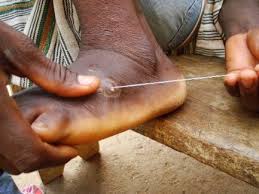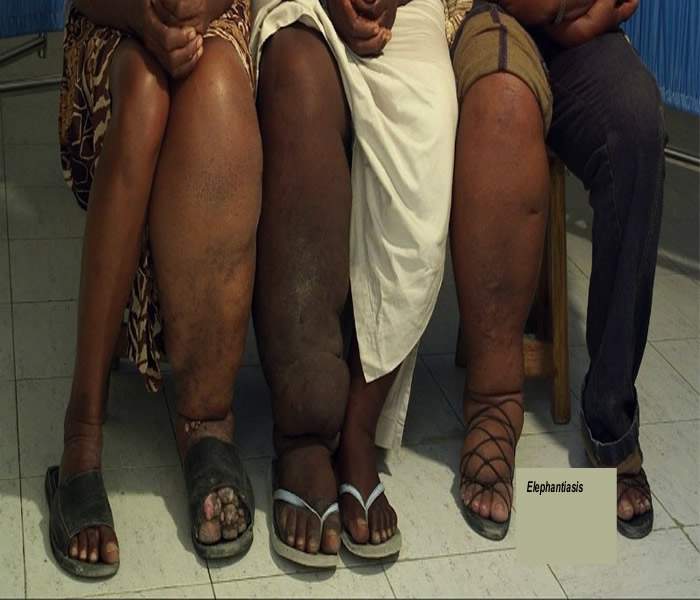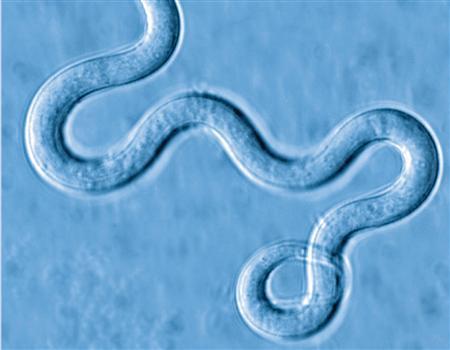
FILARIAL WORMS AND DANGEROUS INFECTION

There are so many diseases that medicine can not define and cure but many of them are coming directly from the unlimited power of the mosquitoes to transfer one of the deadliest illnesses ever.However we look at those aggressive insects, we must ask ourselves what is their real role in the ecosystem beside the bringing the damage to the human race.
If it is not an exotic virus that is ready to eat up our brain and deliver us like a smashed watermelon, then it is definitely a parasite that will crawl into our blood and turn our peaceful lives into the nightmare of Stephen King novels. That doesn’t say much about the ability of humans to adapt on the nature surprises, but about the lack of mankind’s capacity to deal with the silent weapons of the Mother Nature. No matter how progressed we are in technical way, we are still afraid thinking animals.

Could you imagine the disease that is causing an extreme swelling in the arms and legs?The picture itself is very disturbing and it refers on a parasitic infection based on the nematode parasites known as a filarial worms, Wuchereria bancrofti, Brugia malayi, and B. timori.The dangerous parasite is taken from one person to another via female mosquitoes that feeds on human blood and due to its own meal, transfers the infection further:“Elephantiasis is typically characterized by a thickening of the skin and subcutaneous tissue that gives rise to the grossly enlarged and swollen limbs that earn the condition its name. The condition is also called lymphatic filariasis.” The adult worm is located always in lymphatic system of humans so that causes the blockage which indicates the swelling of the certain body parts, making them large and puffy, almost elephant-like.

It is interesting to know that only specific mosquitoes are vectors of this parasite and they are the following: Culex (KYU-lex), Anopheles (a-NOF-e-LEEZ), Aedes (ay-EE-deez), or Mansonia (man-SO-ne-a) so the endemic areas are those that are famous for being a reservoir of tropical or subtropical diseases: South America, Cuba, Puerto Rico, West Indies, Africa, Spain, Turkey, Asia, Australia, and many South Pacific Islands. According to some evidence, about 120 million of people are suffering from this disease and 40 million of them, based on WHO latest reports are developing always the severe form of the infection.

The genesis of the disease is not naive at all. In the areas that are under the high risk of exposing to this worm, almost every person must be aware of these facts:“Worm larvae that make their way into lymph vessels can mature into adult worms. Male worms are long and slender, about 4 to 5 cm long, and 0.1 mm in diameter. Female worms are much larger, 6 to 10 cm long, and about three times wider than the males. The adults make their home mostly near the lymph glands in the lower part of the body. The adult female releases eggs enclosed within an egg membrane (microfilariae), and the microfilariae (mi-kro-fi-LAR-ee-i) develop into larvae to continue the life cycle.In most parts of the world, microfilariae are at their peak in the blood during the night. The worms restrict the normal flow of lymph, resulting in swelling, thickening of the skin, and discoloration. This is what can cause the appearance of an elephant’s leg. However, the swelling of elephantiasis usually does not occur until a person has been bitten by the disease-carrying mosquitoes many times and has had years of exposure to infected mosquitoes”

The Elephantiasis is not the new discovery because the disease itself has been described in old medical books of Greeks and Romans but the awareness of the people is on the rise in last 20 years. The main problem is a long incubation period so the worms have enough time to settle their colonies within the human organism and to cause the final disorder. When larvae reach the third stage of their development, they are searching for a new host and that is exactly how the infection chain is operating.After the circulation is restricted, the elephantiasis became the typical visible outcome of the worms accumulation for the years. The concrete symptoms involves: blocked lymph ducts, brawny skin color, enlarged groin lymph nodes, fever and fibrotic skin tissue, massive leg swelling, skin ulceration,pain in testicles, the grossy skin appearance. Sometimes it is followed with the overall weakness and that goes up with the progression of the worms inside the body.

The accent is on the right diagnosis so the treatment could be enabled as soon as possible. Unfortunately, when it comes to the adult worms, the medicaments have no great success against them so the surgery is rather recommended. The parasite could be seen in blood under microscope but the doctor must have develop the doubts on this disease. In the silent period of incubation, one can not even think of possible infection and the elephantiasis.

The diethylcarbamazine or DEC is used against the worms and it shows the positive results in killing the adult worms and baby worms. The side effects of the illness are definitely connected with bacteria infection that is caused by lack of hygienic standards in regard of the infected swelling zone of the body. Some of the patients have not followed the instructions and they have not treated their affected parts with the soap and safe waters so that caused deeper bacterial infection. The lack of simple exercises turned the targeted body parts into the hopeless damage.

As always, the prevention is a way better than any sanitation. What we need to know before we rise into the tropical and subtropical areas it is more than a crucial for our complete health state. The knowledge will save us all or at least, it will reduce the possibility for us to be hurt by lack of right information in the right time. The spraying to kill mosquitoes and giving antibiotics to prevent infection are just some of the recommendations before you hit the road and find yourself into some of the poor countries that are fighting with the risk of Elephantiasis.

The situation with this disease is almost a paradox. The economically poor countries that have issue with this have no enough financial support to research the cure and those who have material base and support have no real interest to do it. For now, all we can to do is to hope that aggressive worm will not visit us when we visit some of the countries that are known for this parasite and Elephantiasis itself. We also must do all we can to help those who are affected with this dangerous disease and to stop them being neglected by the society and the health system. They are humans too, we own them a help.

Sarah’s excellent article reminded me of Proteus syndrome; a rare congenital disorder that causes skin overgrowth and atypical bone development. Often, it is accompanied by tumors over half the body. Only a few more than 200 cases have been confirmed worldwide, with estimates that about 120 people are currently alive with the condition. As attenuated forms of the disease may exist, there could be many people with Proteus syndrome who remain undiagnosed. Those most readily diagnosed are also the most severely disfigured.
Proteus syndrome is a progressive condition wherein children are usually born without any obvious deformities. Tumors of skin and bone growths appear as they age. The severity and locations of these various asymmetrical growths vary greatly but typically the skull, one or more limbs, and soles of the feet will be affected. There is a risk of premature death in affected individuals due to deep vein thrombosis and pulmonary embolism caused by the vessel malformations that are associated with this disorder. Because of carrying excess weight and enlarged limbs, arthritis and muscle pain may be symptoms, as well.
The Proteus syndrome research team in The National Human Genome Research Institute at the US-National Institutes of Health have initiated a Phase 0 dose finding trial which commenced in November of 2015. Many sources classify Proteus syndrome to be a type of nevus syndrome. The lesions appear to be distributed in a mosaic manner. It has been confirmed that the disorder is an example of genetic mosaicism.
Mandy Sellars (born in 1975, in Lancashire, England) is a woman with a rare genetic mutation that has resulted in extraordinary growth in both of her legs. In 2006, some doctors diagnosed Miss Sellars as having Proteus syndrome. At 19 (in 1994), Mandy Sellars moved out to live on her own. She obtained a B.Sc. in psychology from the University of Central Lancashire, in England, and maintained an independent lifestyle as an adult, with no live-in helpers. She moved around using crutches or a wheelchair, and had a specially modified hand-controlled car.
When Sellars was 28 (in 2003), she suffered a deep vein thrombosis, which left her paralyzed from the waist down for about six or eight weeks. Afterward, she had to learn to walk again. Three years later, she got a blood infection, her kidneys failed, and she contracted MRSA.
Ultimately, it was expected that she would have to have her legs amputated. When the television documentary series Extraordinary People devoted an episode to her called The Woman with Giant Legs (2008), it paid for her trip to The United States of America to consult renowned orthopaedic surgeon Dr William Ertl and prosthetic expert Kevin Carroll. After examining her, they gave her hope that she would be able to have a less drastic amputation than the one recommended by her doctors, which would have severely curtailed her independence.
Her left leg was amputated above the knee in 2010. 22 months after the surgery, her leg began to grow at an accelerated rate and her limb began to balloon again. Almost straight away, the stump began increasing in circumference and it became harder to fit inside the prosthetic leg. The stump eventually got so heavy it nearly broke the prosthetic leg.
Sarah’s article ends on a note of benevolence: for healthy people to consider those suffering from such debilitating and restrictive illnesses as Proteus syndrome. Thank you Sarah for your insightful journalism and encouraging words!
LikeLike
What an excellent article Sandra. It is well-written, informative and beneficial. You pointed out how to prevent such disease from happening to us that I will remember for years to come when I visit one of those disease hosting countries. I look forward to reading your next informative work. Thank you and keep these good articles coming.
LikeLike
Loving the information on this web site, you have done outstanding job on the
blog posts.
LikeLike
Whoah this weblog is wonderful i like studying your posts.
Keep up the great paintings! You recognize, lots of individuals are searching around for
this info, you could help them greatly.
LikeLike
I think you have noted some very interesting points, thanks for the post.
LikeLike
Nice post. I used to be checking constantly this weblog
and I am impressed! Extremely helpful information particularly the final section :
) I take care of such information much. I was
seeking this particular information for a long time.
Thank you and best of luck.
LikeLike
whoah this blog is magnificent i love reading your
articles. Keep up the good work! You recognize, a lot
of people are searching around for this info, you could aid them greatly.
LikeLike
You are so cool! I don’t suppose I have read through a single thing like that before.
So nice to find somebody with some genuine thoughts on this subject matter.
Seriously.. thanks for starting this up. This web site is something that’s needed on the internet, someone
with a little originality!
LikeLike
Hiya, I’m really glad I’ve found this info. Nowadays
bloggers publish only about gossips and web and this is actually irritating.
A good blog with interesting content, this is
what I need. Thank you for keeping this web site, I will be visiting it.
Do you do newsletters? Can’t find it.
LikeLike
Nice post. I was checking constantly this weblog and I am inspired!
Very useful information specifically the remaining phase 🙂 I
maintain such info much. I used to be seeking this particular
info for a very lengthy time. Thank you
and good luck.
LikeLike
I conceive you have observed some very interesting points,
appreciate it for the post.
LikeLike
I do agree with all the concepts you’ve presented on your post.
They are really convincing and can certainly work.
Nonetheless, the posts are too short for starters. May you please lengthen them a little from subsequent time?
Thanks for the post.
LikeLike
Howdy! Do you use Twitter? I’d like to follow you if that would be okay.
I’m definitely enjoying your blog and look forward to new
updates.
LikeLike
I do trust all the ideas you have introduced in your post.
They are really convincing and will definitely work. Nonetheless, the posts are very brief for novices.
May just you please extend them a little from next time?
Thanks for the post.
LikeLike
Hi, this weekend is nice designed for me, since this point in time i am reading this fantastic educational article here at my residence.
LikeLike
Aw, this was a very good post. Taking a few minutes and actual effort to generate a
good article? but what can I say? I put things off a whole
lot and don’t seem to get nearly anything done.
LikeLike
Very great post. I just stumbled upon your blog and wished to say that I’ve
truly loved browsing your weblog posts. After all I will be subscribing on your rss feed and I hope
you write again very soon!
LikeLike
Great beat ! I would like to apprentice while you amend your site, how can i subscribe for a blog web site? The account helped me a acceptable deal. I had been tiny bit acquainted of this your broadcast provided bright clear concept
LikeLike
Do you mind if I quote a few of your articles as long as I provide credit and sources back to your webpage?
My website is in the exact same niche as yours and my users would really benefit from some of the information you present here.
Please let me know if this alright with you. Thanks!
LikeLike
Thanks a ton for writing the idea, I saved the website. I’m also in need of material on Ethereum wallet, have you any idea exactly where I might discover one thing such as that? I will come back in a little while!
LikeLike
“Because the admin of this web site is working, no doubt very shortly it will be famous, due to its quality contents.”
LikeLike
yay google is my queen assisted me to find this outstanding internet site! .
LikeLike
Im thankful for the blog article.Really thank you! Fantastic.
LikeLike
“Great article and right to the point. I don’t know if this is in fact the best place to ask but do you folks have any thoughts on where to get some professional writers? Thank you ??”
LikeLike
“Good website! I truly love how it is simple on my eyes and the data are well written. I am wondering how I might be notified whenever a new post has been made. I’ve subscribed to your RSS which must do the trick! Have a nice day!”
LikeLike
I am so grateful for your blog.Really thank you! Great.
LikeLike
Everyone loves it when folks get together and share views. Great website, continue the good work!
LikeLike
Having read this I believed it was very enlightening. I appreciate you taking the time and effort to put this informative article together. I once again find myself spending a significant amount of time both reading and leaving comments. But so what, it was still worth it!
LikeLike
Hi! I just want to give you a big thumbs up for your great information you’ve got here on this post. I am returning to your web site for more soon.
LikeLike